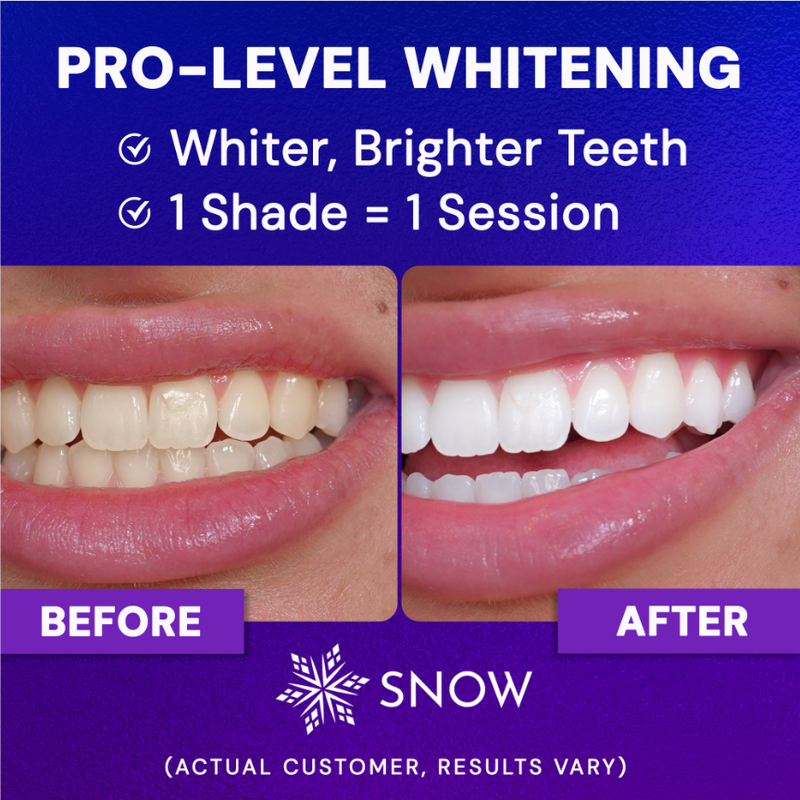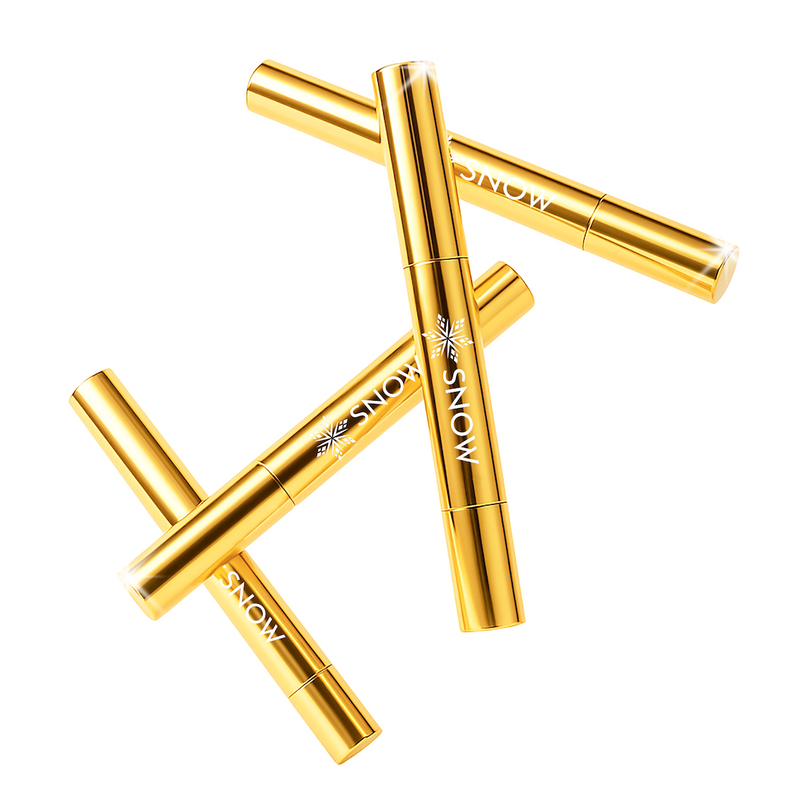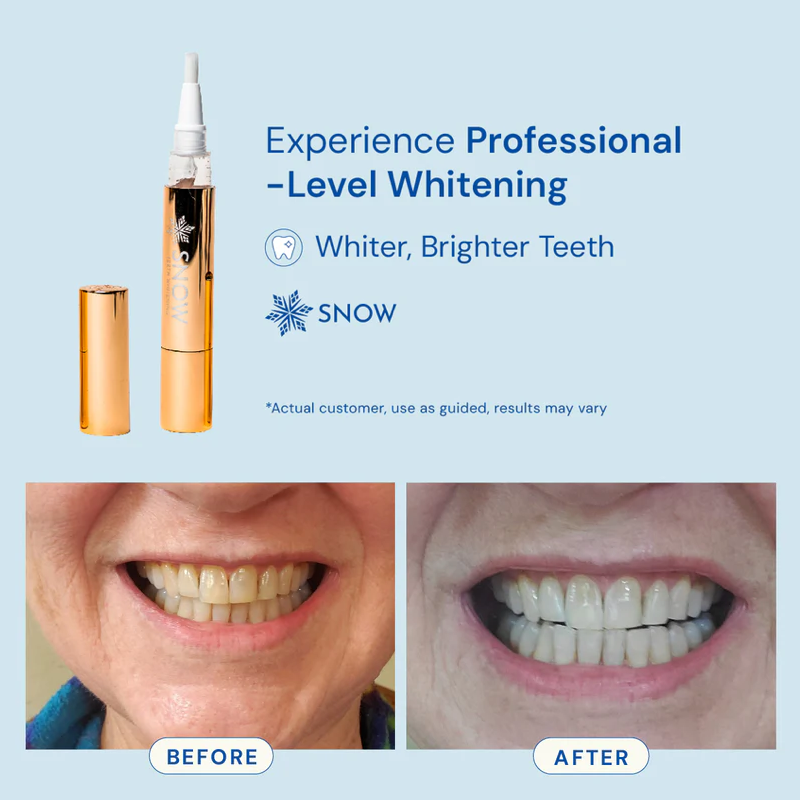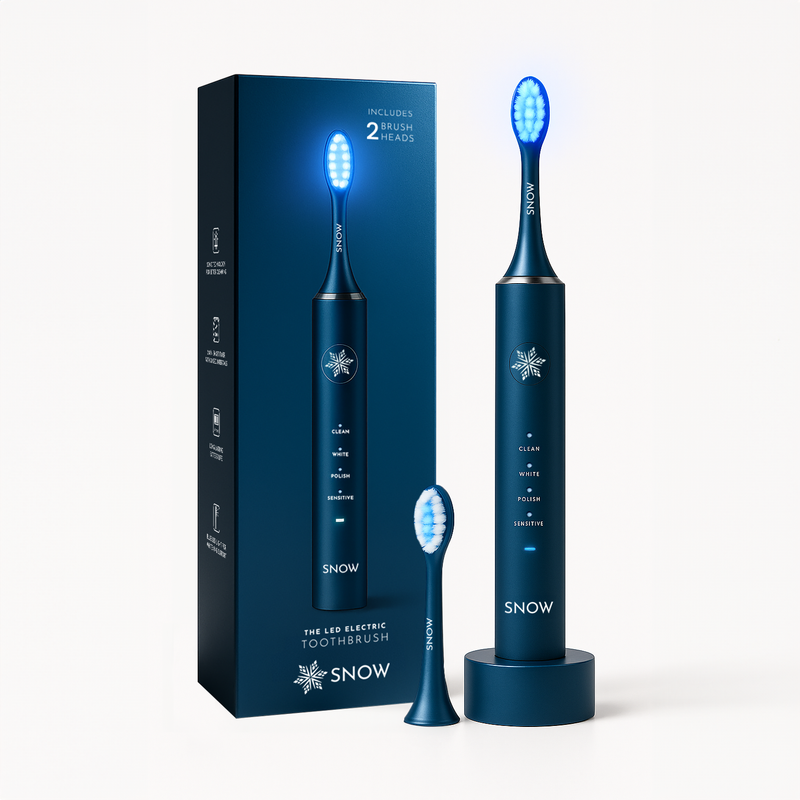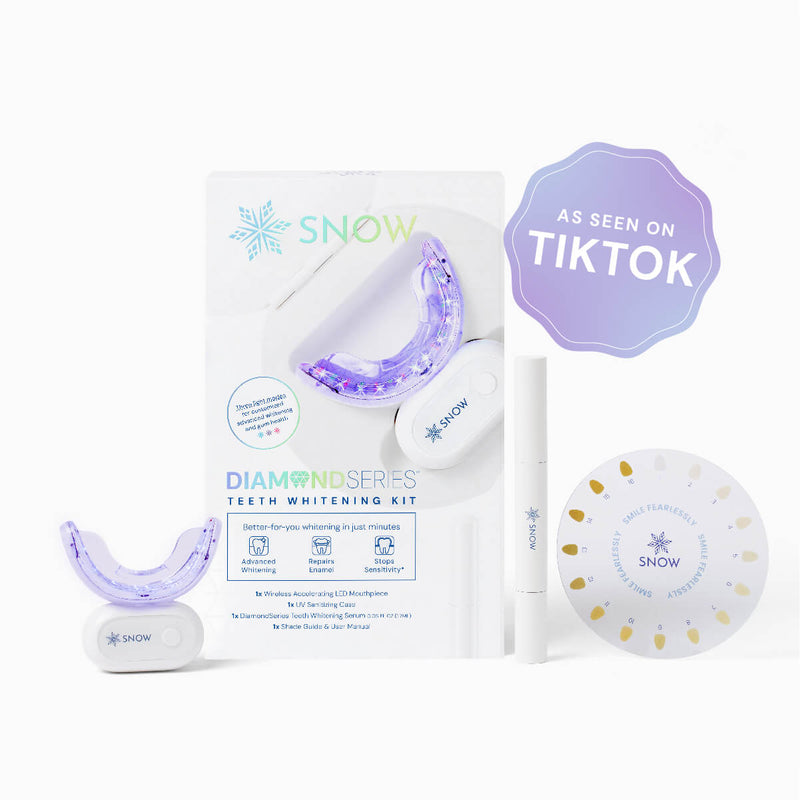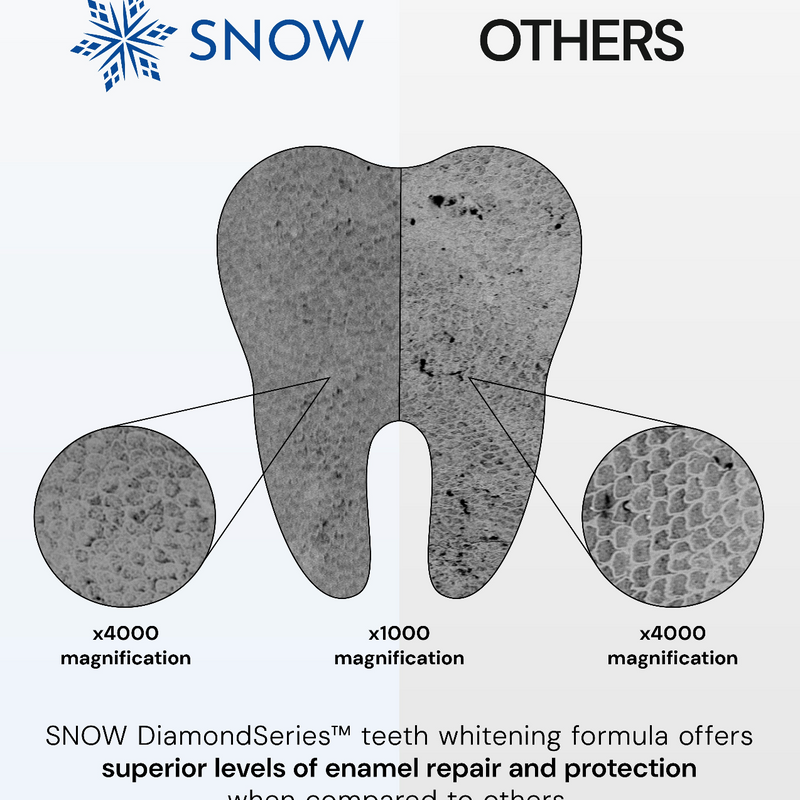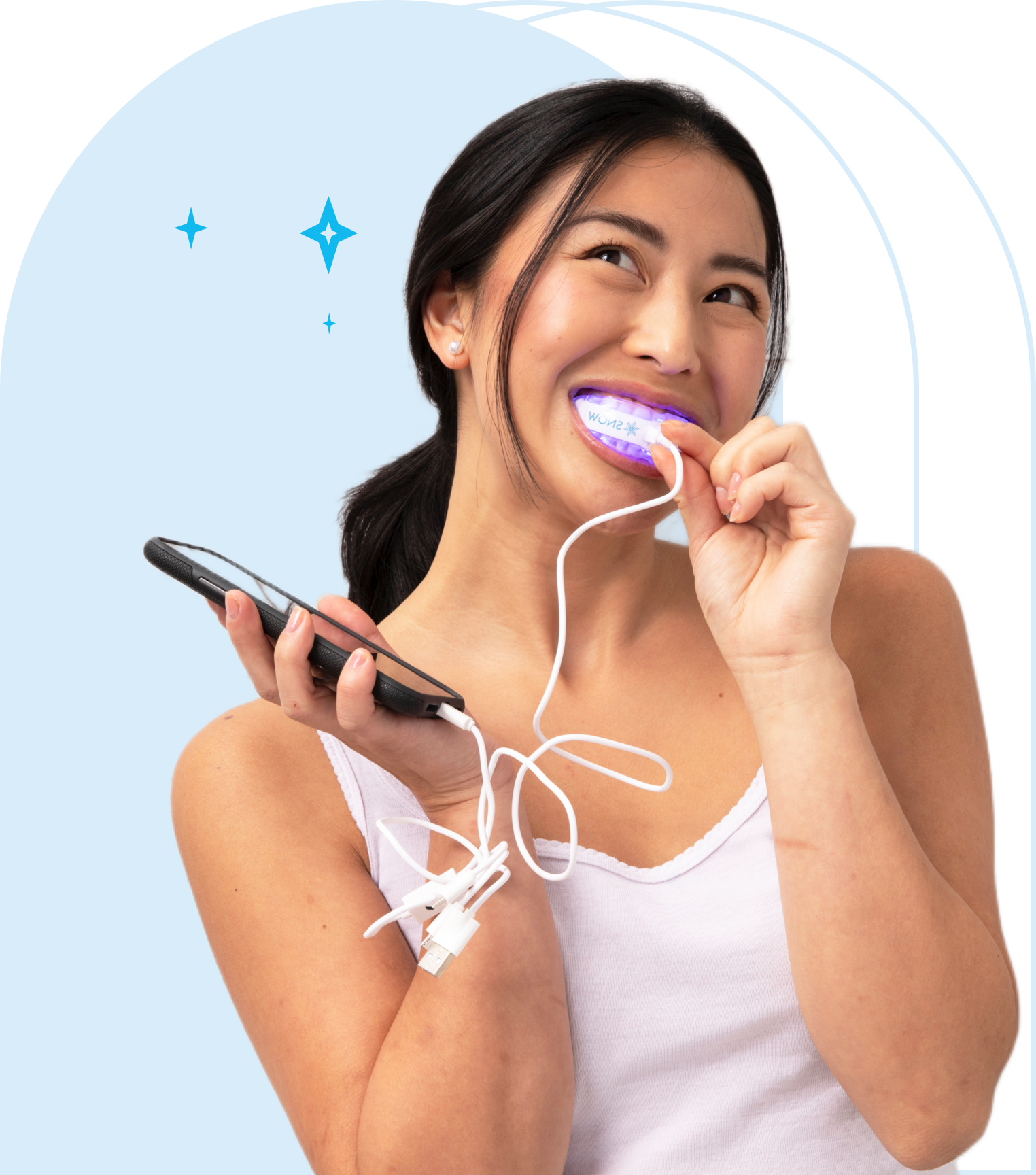When was the last time you changed your electric toothbrush head or thought about whether your toothbrush itself might be past its prime?
While electric toothbrushes do a great job helping you maintain a healthier smile, they only work well if the parts you rely on are in good shape. That means not just replacing the brush head regularly, but also keeping an eye on the handle or base, which can wear out over time too.
In this guide, you’ll learn how to spot the signs of wear, when to replace each part, how to extend your toothbrush’s life, and how to recycle it responsibly. Let’s make sure your toothbrush works as hard as you do.
Key Takeaways
-
Many dental professionals recommend replacing your electric toothbrush head every three to four months to maintain optimal oral hygiene.
-
Look for signs like frayed or discolored bristles, as these indicate the brush head may need to be replaced immediately.
-
Electric toothbrush handles should be replaced every three to five years, especially if you notice battery issues or physical damage, as they may need to be replaced to ensure proper function.
Introduction to Oral Care
Taking care of your teeth is a key part of staying healthy, and using the right tools can make a big difference in your daily routine. The American Dental Association recommends brushing your teeth at least twice a day for two minutes to effectively remove plaque and prevent tooth decay.
Electric toothbrushes have become increasingly popular because they remove more plaque than manual brushes, helping improve gum health and overall oral hygiene. With so many options available, it’s important to choose one that fits your needs.
Regularly replacing the brush head is just as important, it helps prevent bacteria buildup and keeps your brushing effective.
How Often Should You Replace Your Electric Toothbrush Head?
Brushing twice a day is a great habit, but if your brush head is worn out, it might not be cleaning as well as you think. Even if it still looks okay, those bristles may not be doing their job effectively.
The American Dental Association (ADA) recommends replacing your electric toothbrush head every three to four months. Over time, the bristles wear down, lose their shape, and stop removing plaque as thoroughly. If your brush has bristles that are fraying, discolored, or feeling soft, it's probably time for a new one.
Some electric toothbrushes include helpful reminders, like color-fading bristles or subtle changes in vibration when the head is worn. These features are useful, but you should also trust what you see. If the bristles are clearly showing wear, go ahead and replace the head.
Regular replacement also helps avoid the buildup of bacteria that can collect in older bristles. Keeping your toothbrush head fresh is one of the simplest ways to maintain good oral hygiene.
Signs You Need to Replace Your Electric Toothbrush Head Immediately

Most toothbrush heads are made to last around three months—but depending on your brushing habits and health, you may need to replace your electric toothbrush head sooner. Watch for these clear signs:
1. Frayed or Bent Bristles
Once the bristles bend or start to splay outward, they can't reach plaque effectively and may irritate your gum tissue. This is one of the most common signals that it's time to replace your electric brush head.
2. Discoloration
Some heads have fading bristles to indicate wear. Even without this feature, dull or yellowed bristles suggest it's time for a new head to continue maintaining good oral hygiene.
3. Stuck Debris or Residue
If particles or toothpaste remain trapped after rinsing, harmful buildup could be developing. A worn brush head can't remove harmful bacteria effectively, and it should be replaced.
4. Gum Sensitivity or Bleeding
If brushing feels rough, or if your gums bleed or sting, your brush head may be too worn or applying too much pressure on delicate gum tissue. Time to replace your electric brush head.
5. Exposure to Illness
If you’ve recently been sick, it's smart to change your brush head early. A used head can carry harmful bacteria and reinfect your mouth. To maintain hygiene, it’s best to start fresh.
6. Failure to Dry Properly
If your brush head doesn't air dry completely between uses—especially in humid bathrooms—it can harbor harmful bacteria. Proper storage is key, but so is timely replacement.
Your oral care routine depends on a brush that works as it should. Whether you use standard or sonic toothbrushes with a rechargeable battery, don’t ignore the signs. Checking for bristles bent, discoloration, or discomfort helps you stay ahead of problems—and protect your smile.
Make it a habit to replace your electric toothbrush head regularly to maintain hygiene and get the most out of every clean.
Special Circumstances Requiring Earlier Replacement
Most electric toothbrush heads last around three months, but some situations call for replacing them even earlier. Here are a few times when it’s smart to switch heads ahead of schedule:
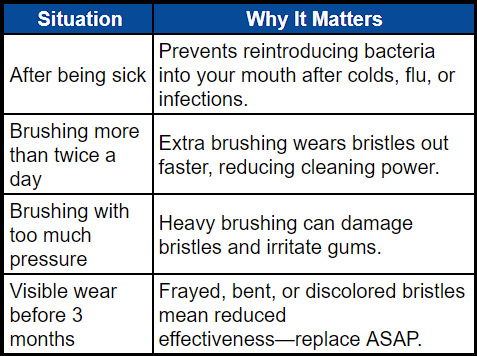
Replacing your toothbrush head early in these cases helps you maintain proper oral hygiene and avoid unnecessary bacteria buildup.
How to Choose the Right Electric Toothbrush Head
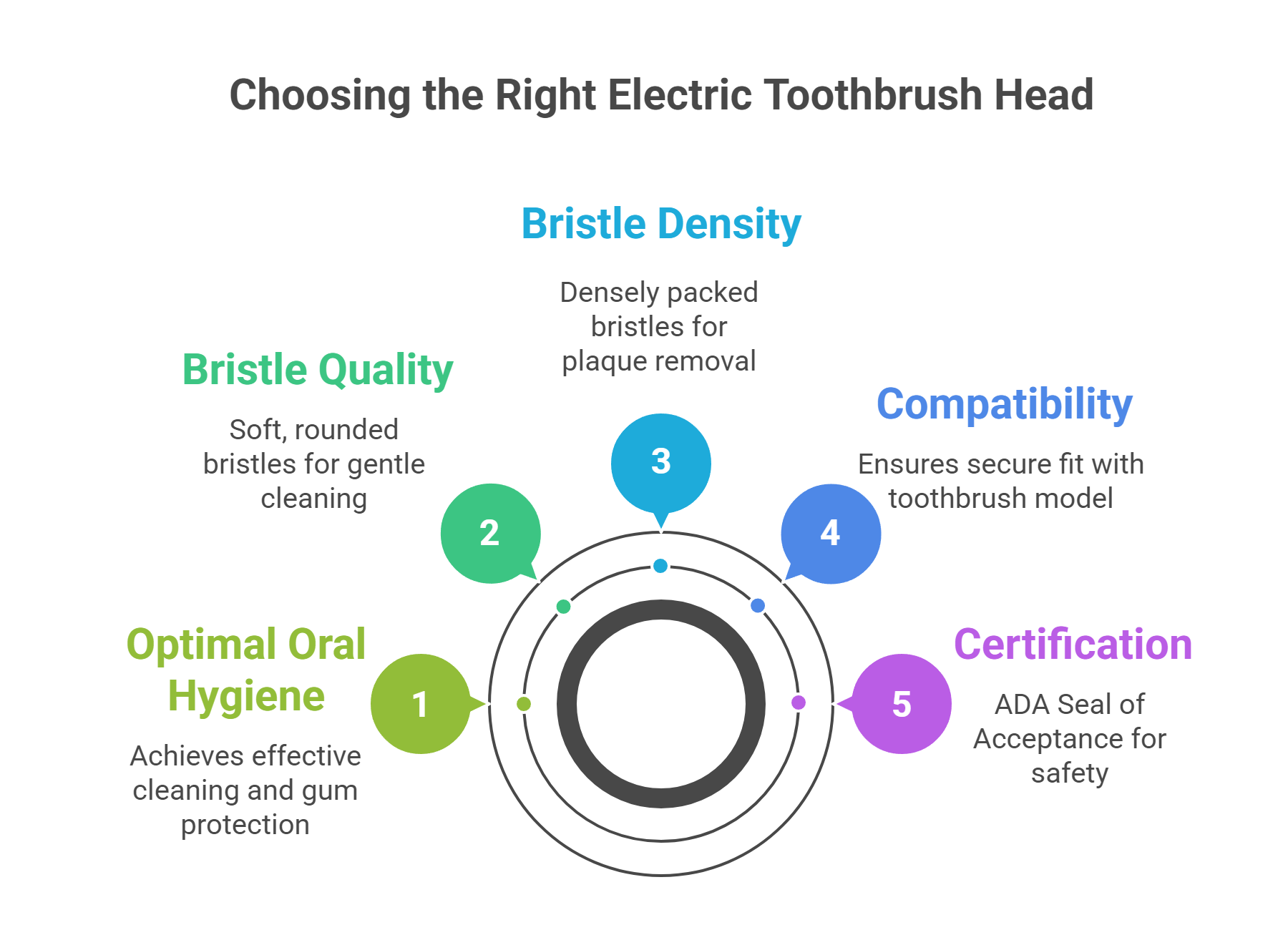
When it’s time to change your toothbrush, choosing the right replacement head matters more than you might think. A quality brush head helps you clean effectively and maintain hygiene with every use. Here’s what to look for:
-
Soft toothbrush bristles with rounded tips to clean thoroughly without irritating your gums
-
Densely packed bristles that remove plaque efficiently across all tooth surfaces
-
Electric brush heads that are compatible with your current toothbrush model to ensure a secure fit
-
Heads that carry the ADA Seal of Acceptance, which confirms safety and performance standards
-
Specialty options designed for sensitivity, whitening, or braces, so you can choose a head that fits your specific needs
-
Replacement heads made by your toothbrush’s original manufacturer to match the handle and motor function
-
A reminder to change your toothbrush head every three months or sooner if you notice wear or reduced cleaning power
Using the right electric brush heads is one of the simplest ways to maintain hygiene, protect your gums, and get the most out of your current toothbrush.
Best Time to Switch Electric Toothbrush Heads (and Why It Matters)
Different electric toothbrush heads serve different purposes—and knowing when to switch can make your brushing more effective.
If you have sensitive gums, look for a new brush head with softer bristles. If you wear braces, use one designed to clean around wires and brackets. Some sonic toothbrushes even offer advanced modes like deep cleaning or whitening, and they work best when paired with heads built for those features.
Even if you’re not dealing with special dental concerns, it’s still important to change your toothbrush head every three to four months. Always follow your toothbrush manufacturer’s guidance, and replace the head sooner if bristles look worn or splayed.
Choosing the right head and knowing when to replace it helps maintain consistent cleaning and keeps your new brush working the way it should.
Why You Should Replace Your Toothbrush Head Regularly
Worn toothbrush bristles don’t just look tired—they clean less effectively. As bristles lose their shape, they remove less plaque and can even irritate your gums.
Studies show that bristle stiffness drops by up to 40% after three months. This affects both manual and electric brush heads, especially when used with sonic toothbrushes, which rely on precise motion for cleaning power.
Old brush heads can also harbor bacteria, contributing to bad breath and potential gum problems. Following the replacement timeline recommended by your toothbrush manufacturer helps you avoid these issues.
Replacing your new brush head on time keeps your mouth cleaner and supports better long-term oral health.
Lifespan of Electric Toothbrush Handles
While replacing the head regularly is important, the handle of your electric toothbrush also has a limited lifespan. On average, you should replace your toothbrush handle every three to five years, depending on how well it’s maintained and how often you brush your teeth.
Several factors affect how long your handle lasts—battery quality, motor wear, and daily usage. For example, features like pressure sensors help protect both your teeth and the motor by discouraging excessive force while brushing, which is especially helpful for people with sensitive teeth.
To keep your toothbrush clean and working properly, regularly wipe down the handle and charging base. This helps prevent buildup of harmful bacteria, especially if the brush is stored in a damp environment.
When Your Handle May Need to Be Replaced Sooner
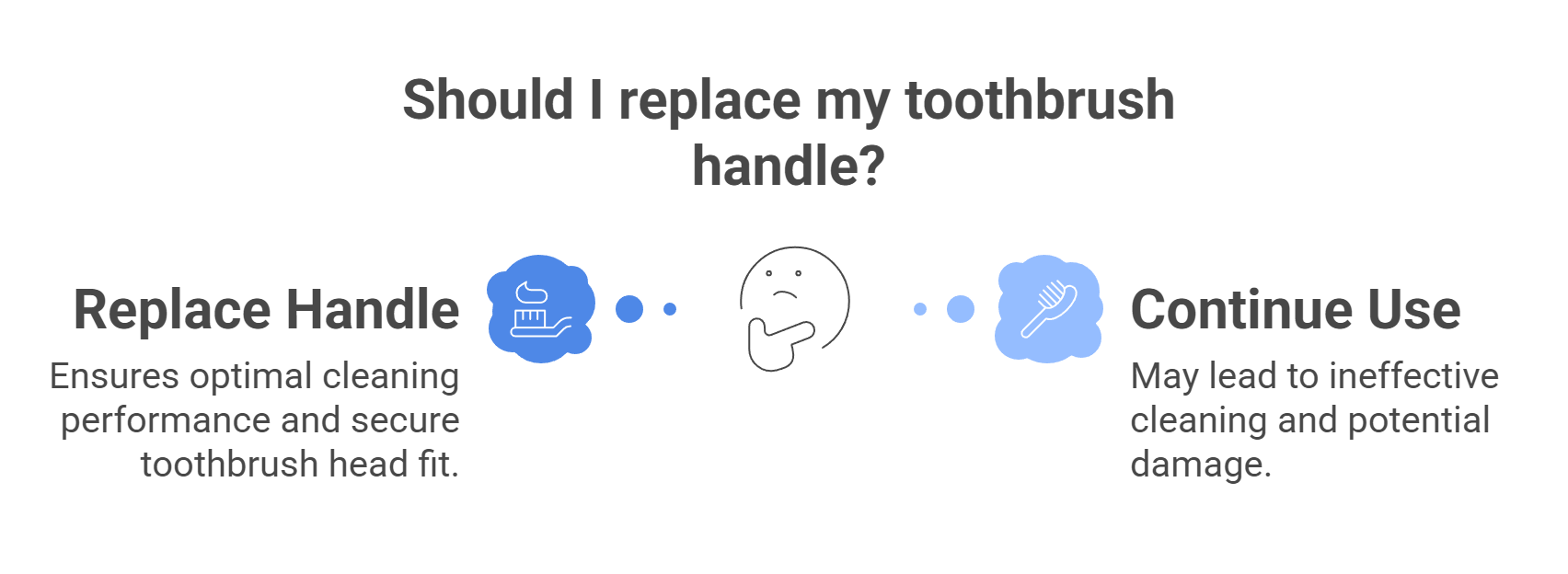
Watch for these signs that your toothbrush handle is wearing out:
-
It won’t hold a charge or the battery drains quickly
-
Vibrations feel weak or inconsistent
-
Brushing power seems lower than usual
-
You hear unusual sounds during use
-
New toothbrush heads no longer fit securely
-
There’s visible damage, like cracks or a faulty charging base
If you notice any of these issues, it’s a good idea to invest in a new toothbrush. While electric models offer better cleaning than a manual toothbrush, they only work well when all parts function as they should.
This is especially important if you have orthodontic braces, where consistent performance is key to keeping hard-to-reach areas clean. Whether you're trying to reduce plaque, fight harmful bacteria, or just keep your toothbrush clean, knowing when to replace the handle ensures you’re getting the full benefit every time you brush your teeth.
Tips for Extending the Life of Your Electric Toothbrush
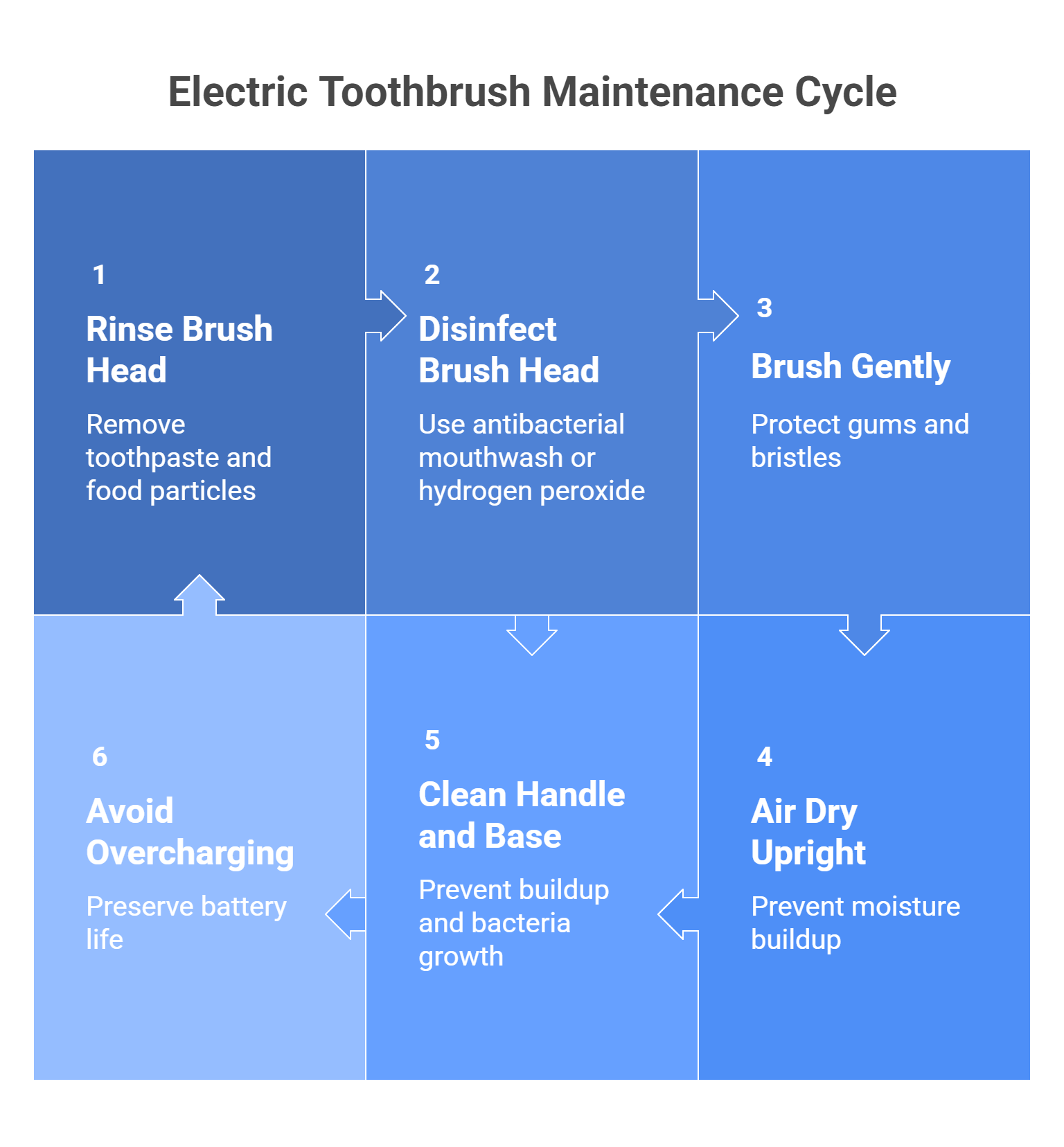
With a little care, your electric toothbrush can last longer and perform better every time you brush your teeth. Here are some simple ways to keep it in top shape:
-
Rinse the brush head thoroughly after each use to remove toothpaste and food particles
-
Disinfect the brush head once a week using antibacterial mouthwash or a quick soak in diluted hydrogen peroxide
-
Avoid brushing too hard—gentle pressure protects both your gums and the bristles
-
Let it air dry upright in a well-ventilated spot; avoid storing it in sealed containers where moisture can collect
-
Wipe the handle and charging base regularly to prevent buildup and stop harmful bacteria from growing
-
Unplug or avoid overcharging the toothbrush to help preserve battery life
If your bristles are fraying or your brush feels rough on your gums, it might be time for a new toothbrush head. Keeping your toothbrush clean and storing it properly helps maintain its performance, reduces wear, and supports better oral hygiene overall.
Common Mistakes to Avoid with Electric Toothbrushes
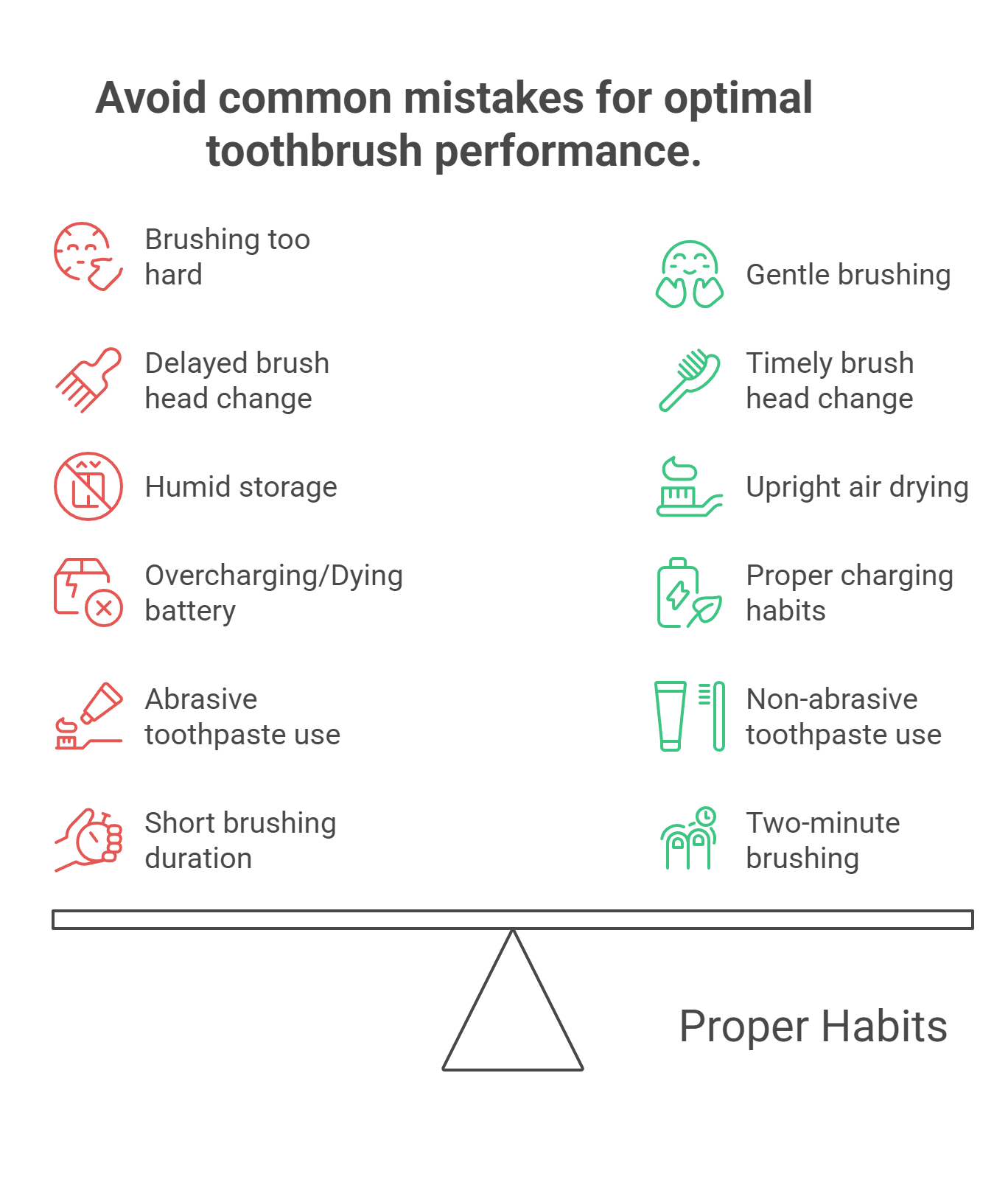
Electric toothbrushes are powerful tools for removing plaque and supporting gum health, but a few common habits can wear them down too quickly and reduce effectiveness.
-
Brushing too hard is one of the biggest mistakes. Excessive pressure leads to frayed bristles, visible wear, and potential gum irritation. If the bristles begin to bend or feel stiff, it’s probably time to replace your brush head.
-
Forgetting to change your toothbrush head on time causes reduced cleaning effectiveness, putting you at risk for gum disease and more plaque buildup.
-
Storing your current toothbrush in a closed or humid space prevents it from drying properly. Always store it in an upright position and let it air dry to avoid bacteria growth.
-
Charging issues matter too. Overcharging or letting the battery die repeatedly can shorten your toothbrush’s lifespan and lead to decreased battery life.
-
Using the wrong toothpaste can also be a problem. Abrasive pastes may damage bristles faster, especially when brushing with pressure.
-
Brushing for less than two minutes or skipping hard-to-reach spots, like around orthodontic braces, limits your toothbrush’s ability to remove more plaque effectively.
To keep your current toothbrush working as it should, follow proper habits, check for visible wear, and don’t wait too long to change your toothbrush or swap in a new brush head when needed.
Where to Buy Replacement Heads and Handles
When your brush shows visible wear or performance drops, it's time to replace the replacement heads or handle. Choosing the right source ensures compatibility, quality, and a longer-lasting brush.
-
Start with your brush brand’s official site. Buying directly from the manufacturer guarantees that the replacement heads and handles match your model, especially if you're using orthodontic braces or a specialized design.
-
Big retailers like Target or Walmart offer genuine products for in-store convenience and quick access to a new brush or spare parts.
-
Online platforms like Amazon provide a wide selection of replacement heads at competitive prices. Just double-check that the seller is reputable and parts match your current toothbrush.
Before switching components, rinse them regularly with warm water, store your brush in an upright position, and allow it to air dry between uses. These habits help extend your brush’s performance and reduce the buildup of harmful bacteria.
Timely replacement of worn parts is essential for preventing gum disease and ensuring your brush can keep doing its job—removing debris, cleaning thoroughly, and protecting your oral health long-term.
Final Thoughts
Maintaining your electric toothbrush isn't just about keeping it running—it’s about protecting your dental health every time you brush. Staying on schedule with replacements, watching for worn or frayed bristles, and keeping your brush clean are simple habits that make a big difference in your oral hygiene routine.
If your current electric brush isn't giving you that fresh, polished feeling, it might be time for an upgrade. Snow’s LED Whitening Electric Brush (Gen 2) combines dentist-recommended features with advanced technology—like sonic vibrations for deep plaque removal and blue light whitening that brightens as you go.
When your brush does more, you do less. Better plaque removal, smarter brushing, and real results—delivered every time you smile.
And now’s the perfect time to make the switch.
Frequently Asked Questions
How often should you replace your electric toothbrush head?
You should replace your electric toothbrush head every three to four months to ensure optimal cleaning effectiveness. Regularly updating the head helps maintain oral hygiene standards.
What are the signs that indicate an electric toothbrush head needs to be replaced immediately?
An electric toothbrush head should be replaced immediately if you notice frayed or bent bristles, discoloration, stuck-on particles, or if it emits unusual sounds or vibrations. Regularly checking these signs can ensure effective oral hygiene.
What are some special circumstances that require earlier replacement of an electric toothbrush head?
It's important to replace your electric toothbrush head earlier if you've been sick, are brushing more frequently than usual, or observe any visible wear and tear. Ensuring optimal oral hygiene is crucial in these circumstances.
How can you extend the life of your electric toothbrush?
To extend the life of your electric toothbrush, ensure you rinse it thoroughly after each use, regularly disinfect it, store it in an open area, and practice gentle brushing techniques. These simple steps can significantly enhance its durability and effectiveness.
Where can you buy replacement heads and handles for your electric toothbrush?
You can purchase replacement heads and handles for your electric toothbrush from the manufacturer's website, major retailers like Target and Walmart, or online platforms such as Amazon.
















































